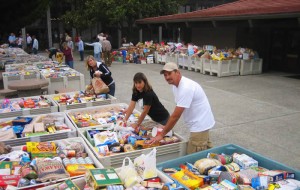 Amid the highest food insecurity rates in nearly a decade, a government shutdown is creating hardship and uncertainty for around 200,000 federal employees, active-duty military members, and people who work for federal contractors in North Carolina. Many hardworking people are just one paycheck away from needing support from their local food bank.
Amid the highest food insecurity rates in nearly a decade, a government shutdown is creating hardship and uncertainty for around 200,000 federal employees, active-duty military members, and people who work for federal contractors in North Carolina. Many hardworking people are just one paycheck away from needing support from their local food bank.
Even before the shutdown, food banks have been experiencing high levels of need. Many food banks across the Carolinas are seeing an increase of 30% or more over this time last year. Some food banks in North Carolina set new records for the number of individuals seeking assistance in September, especially in areas still recovering from Hurricane Helene.
“We need our elected leaders to come together and act,” said Eric Aft, CEO of Second Harvest Food Bank of Northwest NC, and Chair of Feeding the Carolinas. “Shutdowns and short-term fixes are not strategy. Continuing resolutions are not stability. Nutrition programs must be funded fully and predictably so that families, farmers, schools, and health systems are not held hostage to gridlock.”
If the federal government does not find a way to fund SNAP by November 1, Feeding the Carolinas expects to see a sharp rise in hunger across the state. SNAP (also known as food stamps) helps 1.4 million people in North Carolina get enough to eat each month. 43% of North Carolina SNAP households have children living at home.
Cuts to federal and state food programs throughout 2025 have harmed food banks’ ability to meet this rising demand. The USDA and Congress significantly reduced funding to food banks in 2025. And, to date, the state legislature has not continued its historical funding of North Carolina food banks that helps them buy food from North Carolina farmers and distribute where it is needed most.
Private charity, including generous donations from individuals, is crucial to food banks’ ability to meet the increasing need for food assistance in our communities. However, philanthropy cannot replace the volume and stability that federal nutrition programs provide to children, older adults, veterans, and people with disabilities across North Carolina.
Even with robust support, food banks can provide only a fraction of the nutritional assistance that federal programs like SNAP provide. For every meal that a food bank provides to neighbors experiencing hunger, SNAP provides nine.
As need rises, North Carolina’s food banks will continue to show up for their communities, but meeting this challenge requires pulling together. Food banks are calling on our communities to stand united—lawmakers, businesses, faith communities and individuals—to ensure that no one in North Carolina goes without the food they need.
How Individuals Can Help:
- Donate to your local food bank. Food banks are incredibly efficient, with every dollar purchasing multiple meals.
- Volunteer at your local food bank. Bring a friend!
- Call on your elected officials to come together to end the shutdown and fully fund our nation’s food and nutrition programs.
Where to Find Food Assistance:
Individuals who need food assistance can get help to find groceries and meals near them. Food banks partner with thousands of local community organizations to distribute food in every county in North Carolina. To find help near you, use your local food bank’s website (linked below) or call them directly.
North Carolina’s Food Banks:
- Food Bank of the Albemarle (northeast NC)
- Second Harvest Food Bank of Southeast NC (Fayetteville and southeast)
- Food Bank of Central & Eastern North Carolina (greater Triangle region through coastal NC)
- Inter-Faith Food Shuttle (greater Triangle region)
- Second Harvest Food Bank of Metrolina (greater Charlotte area)
- Second Harvest Food Bank of Northwest NC (greater Triad area and northwest)
- MANNA Food Bank (western NC)


